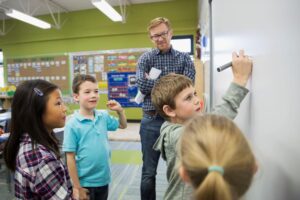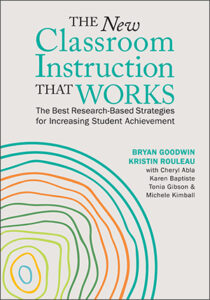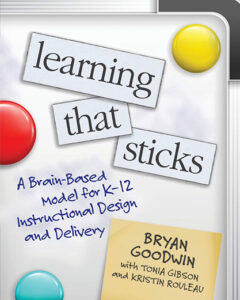
Through our research for The New Classroom Instruction That Works, we identified 14 teaching strategies that support best first instruction, which multiple research studies demonstrate have a significant effect on learning outcomes for a diverse range of students. Each of these strategies is backed by at least seven studies that meet the Institute of Education Sciences’ What Works Clearinghouse review criteria and used scientific research designs, were peer reviewed, and had sufficient sample sizes.
So, let’s dive into the 14 strategies teachers can use in any grade level or content area to improve student achievement, close learning gaps, and ensure equitable outcomes.
Strategy 1: Cognitive interest cues. When teachers can frame a unit/lesson in a way that is stimulating and relevant to their students, they can motivate students’ curiosity and interest in learning. Effective cues relate directly to the desired learning outcomes, help students make a personal connection to the material, and engage students in thinking about what they will learn.
Strategy 2: Student goal setting and monitoring. When students are engaged in their own goal setting and monitoring, it’s easier for them to remain committed to learning. Research shows that clear, achievable, and specific goals are highly effective and better than vague ones. Moreover, student goals should focus on mastery (i.e., what they will learn, not what grade they will earn), and teachers should encourage a growth mindset that celebrates the result of effort, not talent.
Strategy 3: Vocabulary instruction. Words are the pegs upon which we hang ideas, so it’s not surprising that numerous studies show teachers can accelerate student acquisition of declarative knowledge and close achievement gaps when they provide students with direct instruction of subject-specific words and academic terms. It’s worth noting, though, that quality is more important than quantity—students are more apt to internalize new words when they encounter fewer than a dozen new words a week, have opportunities to use them in a variety of ways, and front-load their vocabulary learning with conceptual understanding—that is, not simply memorizing words but fully understanding their meaning.
Strategy 4: Strategy instruction and modeling. Students more readily acquire procedural knowledge when they see new skills, processes, and thinking strategies demonstrated for them—when their teachers, in effect, show and tell students what they need to learn. Many skills are, in fact, not intuitive; students must be taught them directly through modeling and step-by-step demonstrations. The same is true when teaching students how to use thinking strategies (for example, teachers should explicitly teach students how and when to reflect on prior knowledge before reading a text).
Strategy 5: Visualization and concrete examples. As it turns out, all learners are visual learners. So, students benefit greatly from teachers using visual representations to support their comprehension of new ideas and providing them with concrete examples to help them understand abstract concepts. Teachers can support visual learning in a variety of ways, including using diagrams, graphic organizers, illustrations, animations, manipulatives, worked-out examples, videos, and simulations.
Strategy 6: High-level questions and student explanations. Students only learn what they think about. So, teachers should ask high-level questions that prompt students to process what they are learning, explain their thinking, and show them how to ask their own reflective questions. To ensure all students have opportunities to share responses to questions, teachers should pair them with cold-calling techniques (instead of voluntary response techniques) or embed them into small group discussions. Lastly, because the point of questions is to engage students in thinking about their learning, less is more—asking a few high-level questions is always preferred to peppering students with a barrage of low-level recall questions.
Strategy 7: Guided initial application with formative feedback. Immediately after seeing a new skill modeled or demonstrated, students need opportunities to translate their new learning into action while receiving ample support, guidance, and feedback. Teacher feedback should progress as learning does, by starting with tailored feedback based on observations, then formative feedback to prompt student reflection and self-correction, and followed by progress feedback to aid automation. Notably, studies show students can shorten their learning curves when they achieve at least three correct responses during initial practice sessions.
Strategy 8: Peer-assisted consolidation of learning. Consolidation—connecting ideas into neural networks—is the key to learning. Thus, students need frequent opportunities to pause and process their learning—often in small groups or pairs that provide them opportunities discuss, practice, and think through new learning. In other words, peer-learning should complement (not replace) direct instruction. Research shows that peer learning is most effective when it is highly structured (with teacher-provided prompts and protocol), supports individual accountability with positive interdependence, and engages mixed-ability groups of students in processing learning together.
Strategy 9: Retrieval practices (quiz to remember). Research shows one of the best ways to embed new learning into our long-term memory is to quiz ourselves on it. As it turns out, the very act of racking our brains to recall prior learning strengthens our memory of that new learning. So, while quizzing (or retrieval practice) is often used to measure learning, it is a far more effective teaching strategy (and more effective than most other forms of studying). That said, teachers should use frequent ungraded quizzes as a means, not an end to learning—to help students build the foundational knowledge they need to engage in deeper learning.
Strategy 10: Spaced, mixed independent practice. Research shows the key to storing new learning in long-term memory is to re-engage with it before it fades from memory by engaging in practice (or re-learning sessions) spaced over days and weeks. Studies also show that practice is more effective when we engage in practicing a variety of skills or knowledge—forcing our brains to switch back and forth between problem types, which further strengthens our neural connections. These two principles come together as spaced, mixed practice—ensuring students participate in multiple (at least three) practice opportunities that engage them in recalling a mix of new and previously acquired learning with each practice session spread a few days apart.
Strategy 11: Targeted support (scaffolded practice). Many students fail to master new learning when they first encounter it—even when they receive high-quality instruction. So, it’s important for teachers to check student progress regularly to identify students who could benefit from re-learning and re-practicing knowledge and skills they initially struggle to master. Although some might see targeted supports as Tier II instruction, research makes a powerful case for every teacher building it into their repertoire of best first instruction strategies, because at some point, most students need some additional help to master new learning.
Strategy 12: Cognitive writing. Extended writing assignments are one of the best ways for students to consolidate new learning into long-term memory—by synthesizing, analyzing, evaluating, and expressing their own ideas about what they are learning. And while writing and critical thinking skills are often linked, it’s important for teachers to provide their students direct instruction in thinking and writing strategies and scaffold their writing with graphic organizers and other guides that help them arrange their thoughts as they put them on paper.
Strategy 13: Guided investigations. Several studies show that giving students the opportunity to think deeply about learning helps them encode that learning into long-term memory. We can do that by giving them opportunities to engage in experiments, inquiry-based learning, and research projects that balance student self-directed investigation with teacher-guided learning.
Strategy 14: Structured problem solving. Like guided investigations, engaging students in using what they’ve learned to solve real-world problems helps them to embed learning deep into long-term memory. When engaging students in solving a complex problem, it’s important for teachers to offer students step-by-step guidance for dissecting the problem to understand it and retrieving prior knowledge and skills to solve it. Doing so helps students to develop the mental schema they need to solve similar problems later. Research shows that structured problem solving not only serves as an effective way to anchor learning, but also increases student motivation and closes learning gaps.
Intentional use of the strategies
Having these strategies in your back pocket is only half of the equation for delivering best first instruction. Understanding how and when to use them to engage students in deep learning is the second part; essentially, we must understand how these strategies support the process of learning and what point of a unit or lesson to use them. That’s where the six-phase learning model from our Learning That Sticks book comes in.
To learn anything, students must become interested in it (the first phase); followed by deciding they will commit to learning (the second phase). As they begin to learn new knowledge and skills, juggling information in their short-term working memory, students must focus on new learning (the third phase), and then, because our brains can only handle so much new knowledge at a time (information overload, anyone?), pause and process to make sense of new learning (the fourth phase). To help new learning settle into our long-term memory, we need to help students practice and reflect (the fifth phase) prior to giving them opportunities to extend and apply their learning (the sixth phase), which one of the most important, yet often overlooked phases of learning.
Now, let’s crosswalk the six phases with the 14 strategies, so you can see which strategies work best with each phase of student learning. (Click here for a more detailed handout.)
| Brain-Based Phases of Student Learning (student actions) | Research-Backed Instructional Strategies (teacher-directed actions) |
| Phase 1: Become Interested | Strategy 1: Cognitive interest cues |
| Phase 2: Commit to learning | Strategy 2: Student goal setting and monitoring |
| Phase 3: Focus on new knowledge | Strategy 3: Vocabulary instruction Strategy 4: Strategy instruction and modeling Strategy 5: Visualizations and concrete examples |
| Phase 4: Make sense of learning | Strategy 6: High-level questions and student explanations Strategy 7: Guided initial application with formative feedback Strategy 8: Peer-assisted consolidation of learning |
| Phase 5: Practice and reflect | Strategy 9: Retrieval practice (quiz to remember) Strategy 10: Spaced, mixed practice Strategy 11: Targeted support (scaffolded practice) |
| Phase 6: Extend and apply | Strategy 12: Cognitive writing Strategy 13: Guided investigations Strategy 14: Structured problem solving |

 Want to learn more about effective teaching strategies and classroom tips for each, best first instruction, and the brain-science phases of student learning? Check out these resources:
Want to learn more about effective teaching strategies and classroom tips for each, best first instruction, and the brain-science phases of student learning? Check out these resources:
– The New Classroom Instruction That Works
– Research-Based Instructional Strategies That Work (Quick Reference Guide)
– Learning That Sticks
– Using Brain Science to Make Learning Stick (Quick Reference Guide)
– Tools for Classroom Instruction That Works


